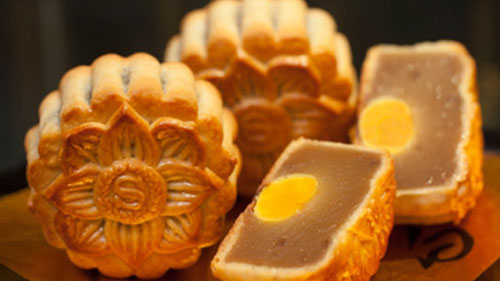Mooncake markets bustle ahead of festival
With a few weeks to go until the traditional Mid Autumn Festival which is held on the 15th day of the eighth lunar month, HCM City is already bustling with people buying mooncakes for relatives and friends.
The mooncake is a symbol of Mid Autumn Festival celebrated by Vietnamese for centuries. Parents and teachers often tell the real story behind the cake's history to the children at a very early age.
"My teacher told us that bakers make round cakes to represent the universe and square cakes to replicate the world," says Phan Hoang Thu Anh, a fourth-grade student at Vietnam and Australian International School, who was recently taught how to make mooncakes by her teacher.
Anh says that the lotus and green bean paste inside the cakes represent nature and people, while the egg symbolises yin and yang, the ancient Chinese philosophy of positive and negative forces.
 |
The mooncake comes in two varieties, sweet banhdeo (sticky rice cake) and savoury banhnuong (baked cake).
To make banhdeo, bakers use quality sticky rice powder, sugar, lotus seeds (or green beans), melon seeds and sweet almonds.
Banhnuong, however, is filled with salted egg yolk, sausage, roast chicken and other traditional ingredients.
"I like playing with the mooncake much more than eating. The cake isn't only a type of food but also symbolises life and people," she adds.
Anh's teacher, PhanThiAnh, says:" I think we should teach our children about the cake's cultural values."
Anh and her classmates will celebrate the festival by making the cake at home and then eating it at school.
The first mooncake bakers in HCM City were Chinese-Vietnamese residents who lived in District 5's China town in the 1940s.
In 1960, popular mooncake bakeries, such as Dong Khanh, Long Xuong and Dong Hung Vien, began to deliver and sell their products to other southern and central provinces.
Over the years, bakers have gained experience and after experimenting with their own ingredients, like black beans, taro, salangane bird nest and shark fins, have created many different styles of mooncakes.
"Because of the mooncakes' symbolism, Vietnamese families always use the cake to worship their ancestors during the mid-autumn occasion," says Nguyen Thi Ngoc, a seller of Kinh Do Food Corporation, which offers 2,800 tonnes of mooncakes this season, an increase of 15% compared to last season.
Ngoc says that Saigonese enjoy mooncakes produced by bakeries like Kinh Do and NhuLan because of "their original Vietnamese taste".
But many housewives still make homemade cakes every year for their family and friends.
"Making homemade cakes means I can put my own originality into them," says Tran ThiAnhLinh, a resident of District 5.
Linh, 65, learnt making the mooncake from her mother, a Chinese-Vietnamese woman who married a Vietnamese.
"Today, people are willing to buy the mooncake two months before the festival begins. This trend creates more opportunities for bakers and confectionery companies," she says.
Browse through any market or bakery around the city at this time and you will come across a variety of mooncakes, including those made by luxury hotels.
A banhdeo made with green beans, lotus seeds and salted egg yolk, costs VND90,000-VND120,000 (US$4.3-5.7), depending on its weight. While a banhnuong, made with salted egg yolk and roast chicken costs VND150,000-VND180,000 (US$7.1-8.6).
Special banhnuong, made with bird's nest and shark fins, costs at least VND400,000 (US$19) each. The largest, weighing a kilo, costs about VND1 million (US$48).
Banhnuong at hotels is priced at VND800,000 (US$38) to over VND1 million for a box of four cakes.
Small bakeries in rural districts provide small cakes, about 100-120 grams each, for between VND50,000 (US$2.4) and VND70,000 (US$3.3).
According to Bibica Corporation, one of the city's largest mooncake producers, the company plans to provide more than 530 tonnes of mooncakes this festival, an increase of 15% over last year.
"Apart from selling our products in HCM City, we have opened 12,000 outlets in the country," says a representative of Bibica.
In June, Kinh Do exported more than 100,000 mooncakes to the US and has prepared to sell the cakes to foreign markets including France, Australia and Cambodia.
In northern provinces, mooncakes under the brandnames like Hai Ha, Huu Nghi and Hanoi, are popular among customers.
